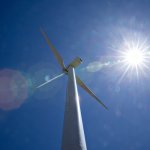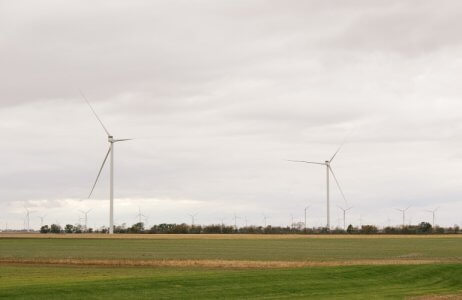By Rob Budny, VP of Renewables, SparkCognition
The Russian invasion of Ukraine exposed the starkest challenges of fossil fuel dependence on a global level. The volatility of record-high power and fuel prices rocked economies and consumers while global CO2 emissions soared to a historic high and put the goals of the Paris Agreement at risk. A growing number of countries, regions and individual organizations are making carbon neutrality an overriding priority by taking decisive and urgent actions to accelerate the deployment of renewables to ease economic pains, lower costs and put the world on the yellow brick road to net zero.
Within the net-zero ruminations and subsequent actions, wind energy is the dominant player in the renewable decision-making process today. In the United States, wind outpaced coal in 2019 in the amount of energy provided and is now the country’s largest renewable energy source. The global offshore wind sector realized a banner year for deployments in 2021, with 17,398 MW of new projects commissioned, pushing the global installed offshore capacity past 50 GW. According to the Global Wind Report, 2022 was another strong year for wind installations, with 94 GW installed around the world. To stay on track with global net-zero goals, installations will need to add 180 GW per year effective immediately to maintain climate change to less than 2° C, and 289 GW at the start of 2030 to meet 2050 commitments. Profit pressures also need to be minimized while meeting higher standards of reliability and performance.
As installations rise, so do operational and business challenges — safety and worker welfare, operational continuity, and maintaining cost efficiency. The operation and maintenance of wind farms are complicated, exacerbated by varying environmental conditions, especially offshore. Although more efficient than onshore, O&M activities attribute upwards of 30{7bfcd0aebedba9ec56d5615176ab7cebc5409dfb82345290162ba6c44abf8bc8} of overall costs due to inaccessibility issues, corrosion from seawater and harsher weather conditions.
Mechanical and engineering marvels, wind turbines are expensive and complex and have become the archetype of industrial IoT in action. Sensors, monitors and actuators play outsized roles in keeping turbines operational by generating volumes of current and historical operating data such as rotor speed, yaw angle, component temperatures, motor currents and vibration data. Other data types captured are production totals, power curves, availability metrics, alarms, warnings, fault data and exogenous weather conditions. Data that is not included, out-of-range or corrupted can result in a myriad of challenges and risks.
Digitalization is a game-changer for wind energy generation, but the overwhelming amount of data being generated needs to be analyzed to ensure turbines perform at peak efficiency and without issue. Smart turbines are beginning to hit the market with hundreds of embedded sensors that can continuously transmit hundreds of gigabytes of data per day. Even with a bank of full-time analysts, the sheer volume of data and disparate interpretations can push an entire team to analysis paralysis, where they are frozen in indecision.
The business case for AI for wind energy
Wind has the potential to be the custodian of the energy transition, but complicated economies could threaten its position. A competitive marketplace gave farm operators leniency to pressure suppliers to drive down costs. Increased steel prices, supply chain disruptions, rising interest rates and other economic factors put a kibosh on cost flexibility. Prices are going up, and margins on both the supplier and wind farm sides are thin. The price of electricity from wind farms needs to increase to facilitate ongoing investments required to achieve climate goals.
Without environmental pressures, wind farm operators might respond to such challenges by cutting expenses or putting the brakes on deployments. Those strategies are not feasible for generating long-term economic benefits or meeting net-zero goals. Wind energy requires additional technologies to maintain its position on the alternative energy pedestal.
AI technologies can extract, manage and interpret large streams of raw data that are transformed into predictive and prescriptive insights to address a range of challenges plaguing the wind energy industry, all in real time. AI predictive maintenance can improve planning, predict asset performance to prevent failures and downtime, identify underperforming assets and ensure effective follow-through. Profitability is improved via increasing energy production, maintenance costs are reduced, safety is increased, and operational efficiency is maximized.
An AI-enabled asset management platform built explicitly for renewable energy can incorporate data from all asset types, including SCADA systems, weather and market pricing, to monitor real-time asset performance and production metrics. It can create self-help analytics and visualize key performance metrics and AI models so appropriate actions can be taken to optimize energy production. It can customize visualizations utilizing asset data and calculated metrics and customize and automate periodic reporting to meet essential stakeholder requirements. Reports can be developed instantly using any data parameters, including production, revenue, availability, fault data, maintenance costs and time, parts usage, anomaly detection and physics-informed predictive analytics and advanced AI can be utilized to prevent failures and reduce maintenance costs.
AI can also automatically detect underperforming or malfunctioning assets and send alerts to ensure timely and effective maintenance for asset longevity. Analysts and technicians spend less time processing and managing data and more time executing solutions that increase equipment uptime and productivity. AI technology can also provide visibility into future spare parts needs and advanced planning of crane callouts to help avoid unnecessary costs and inefficient use of staff time, which reduces parts inventory, and repair turnaround times mean more generation and revenue. The consistently repeated actions facilitated by AI creates a compound effect for realizing the big returns the wind energy industry needs.
Use case: Predicting wind turbine pitch bearing failures
Pitch bearings connect the blade to the rotor hub and allow the blade angle to be indexed for optimal production at any given wind speed. Bearings are designed and certified to last for at least 20 years, yet only a small percentage survive that long in the field. Bearings fail prematurely for a variety of reasons including fatigue, lubricant degradation, improper handling or mounting or contamination. The lead time and cost incurred to replace bearings is very high, often involving deployment of a crane.
Pitch bearings are typically inspected manually every six to 12 months during periodic maintenance, making early detection of issues difficult and expensive. The diagnosing begins with analyzing samples of bearing grease, which provides a bit of insight based on the amount and size of the wear particles in the grease. The turbine must be taken offline for inspection so technicians can enter the hub to pull the samples.
A best-case situation is predicting failures in advance. AI uses data from existing sensors on the turbine to detect pitch bearing issues remotely. Signals can include commanded pitch position, actual pitch position, pitch motor current and temperature (for electric pitch systems), pitch system pressures (for hydraulic pitch systems), turbine fault history and other relevant indicators.
Pitch bearing health algorithms running on an AI cloud computing platform 24 hours a day require no input from analysts. The algorithms are used on turbines’ existing signals, so no additional hardware is required. Data is continually sent to the platform, which means the system is not taken offline nor does anyone have to physically climb the turbine. When the model predicts the pitch bearing may fail, the AI technology automatically notifies technicians to address the issue.
Failures are predicted with over 90{7bfcd0aebedba9ec56d5615176ab7cebc5409dfb82345290162ba6c44abf8bc8} accuracy up to six months in advance. It gives project owners a satisfactory lead time to order and replace them. It minimizes turbine downtime and precludes multiple crane callouts which can save operators over $150,000 per site visit when repairing pitch bearings on multiple turbines.
Use case: Identifying wind turbine yaw misalignment
Deficient turbine yaw alignment is directly associated with lost energy production, and it exposes the turbine to increased loads. Yaw misalignment is typically identified using light detection and ranging (LiDAR) measurement or physics-based methods applied to turbine SCADA data.
While both techniques can be effective, they have significant disadvantages compared to AI. LiDAR is costly and physics-based methods require data over an extended period (typically one year) when yaw misalignment is present. A machine learning-based solution can act as an extension of the physics-based method by using only two months of historical data to train the machine learning model to detect a yaw misalignment of 5° or more with 96{7bfcd0aebedba9ec56d5615176ab7cebc5409dfb82345290162ba6c44abf8bc8} accuracy. An analyst is automatically notified with the magnitude and direction of yaw misalignment (positive or negative) so the issue can be quickly corrected, and the turbine returned to optimal operating condition. An AI cloud computing platform runs 24/7 with no input required from analysts. No safety risks or additional costs are incurred from tower climbs, and turbines are kept operating at peak performance.
In one specific situation, an operator updated the turbine yaw offset remotely and resulted in as much as 2{7bfcd0aebedba9ec56d5615176ab7cebc5409dfb82345290162ba6c44abf8bc8} additional annual energy production (AEP) — an annual revenue increase of $45,000 for the project.
Conclusion
Wind power is a technologically mature energy source with undeniable environmental and economic benefits. It has all the necessary criteria to maintain its leading role in the global energy transition. Significant impacts are being realized from larger turbine sizes onshore and offshore. The increases in rotor diameter and hub height are creating massive improvements in wind-generated electricity and moving the needle on overall energy prices on a grand scale.
According to a survey by Lawrence Berkeley National Laboratory of the world’s preeminent wind power experts, technological advancements will be a crucial player in helping drive down the cost of energy between 17 to 35{7bfcd0aebedba9ec56d5615176ab7cebc5409dfb82345290162ba6c44abf8bc8} by 2035 and 37 to 49{7bfcd0aebedba9ec56d5615176ab7cebc5409dfb82345290162ba6c44abf8bc8} by 2050. AI is the most important technology a wind operator can deploy. It stands ready to deliver full-featured performance 24/7/365, providing everything operators need to ensure continued profitable operations.
As the world races to unwind a century of fossil fuel-powered energy production, the companies that embrace AI technologies today will be adequately poised to simultaneously optimize their operational efficiencies and maximize profitability while playing a central role in the evolution of a new sustainable world. The wave will be felt throughout the entire global economy.
 Rob Budny is VP of Sales for Renewable Energy where he leads the sales organization for SparkCognition’s Ensemble Asset Performance Management solution for renewable energy operators. He holds a Bachelor of Mechanical Engineering degree from the University of Maryland, Baltimore County.
Rob Budny is VP of Sales for Renewable Energy where he leads the sales organization for SparkCognition’s Ensemble Asset Performance Management solution for renewable energy operators. He holds a Bachelor of Mechanical Engineering degree from the University of Maryland, Baltimore County.
Filed Under: Featured


